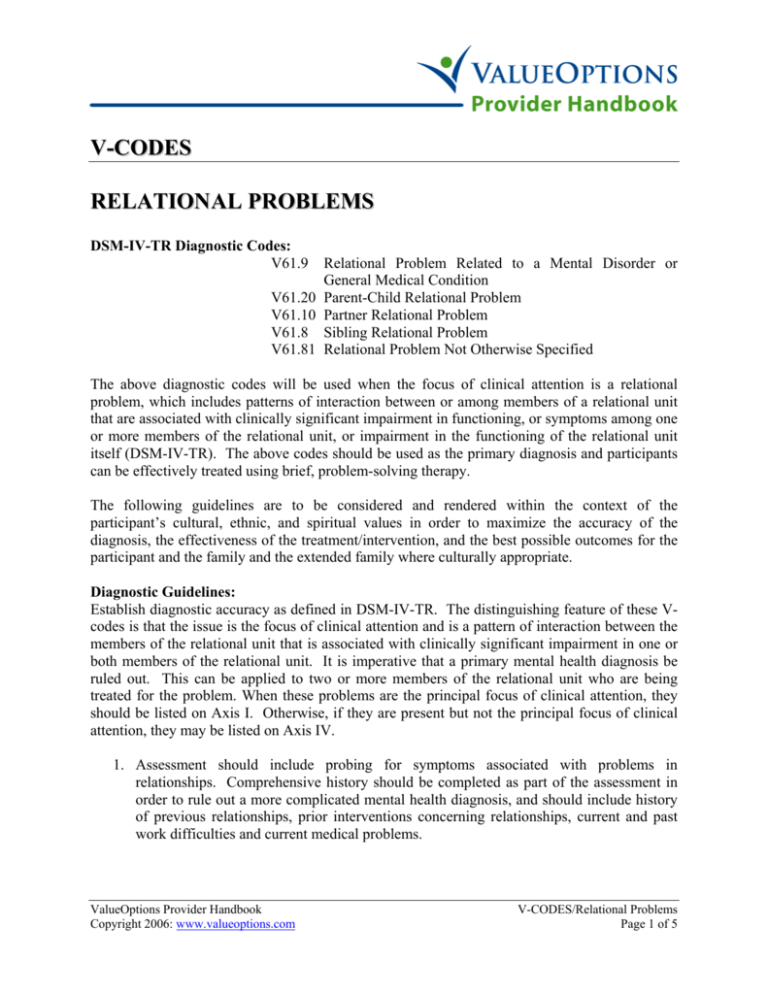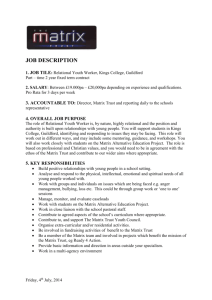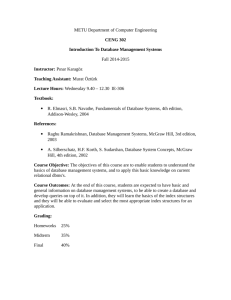v-codes relational problems
advertisement

V-CODES RELATIONAL PROBLEMS DSM-IV-TR Diagnostic Codes: V61.9 Relational Problem Related to a Mental Disorder or General Medical Condition V61.20 Parent-Child Relational Problem V61.10 Partner Relational Problem V61.8 Sibling Relational Problem V61.81 Relational Problem Not Otherwise Specified The above diagnostic codes will be used when the focus of clinical attention is a relational problem, which includes patterns of interaction between or among members of a relational unit that are associated with clinically significant impairment in functioning, or symptoms among one or more members of the relational unit, or impairment in the functioning of the relational unit itself (DSM-IV-TR). The above codes should be used as the primary diagnosis and participants can be effectively treated using brief, problem-solving therapy. The following guidelines are to be considered and rendered within the context of the participant’s cultural, ethnic, and spiritual values in order to maximize the accuracy of the diagnosis, the effectiveness of the treatment/intervention, and the best possible outcomes for the participant and the family and the extended family where culturally appropriate. Diagnostic Guidelines: Establish diagnostic accuracy as defined in DSM-IV-TR. The distinguishing feature of these Vcodes is that the issue is the focus of clinical attention and is a pattern of interaction between the members of the relational unit that is associated with clinically significant impairment in one or both members of the relational unit. It is imperative that a primary mental health diagnosis be ruled out. This can be applied to two or more members of the relational unit who are being treated for the problem. When these problems are the principal focus of clinical attention, they should be listed on Axis I. Otherwise, if they are present but not the principal focus of clinical attention, they may be listed on Axis IV. 1. Assessment should include probing for symptoms associated with problems in relationships. Comprehensive history should be completed as part of the assessment in order to rule out a more complicated mental health diagnosis, and should include history of previous relationships, prior interventions concerning relationships, current and past work difficulties and current medical problems. ValueOptions Provider Handbook Copyright 2006: www.valueoptions.com V-CODES/Relational Problems Page 1 of 5 2. Consider the following behaviors and/or symptoms: a. Recurring arguments and conflict between two individuals which cause preoccupation and/or distract from activities of daily living. b. Lack of communication and/or withdrawal between the individuals which results in frustration and/or anger. c. Inappropriate kinds of communication between individuals which can include unrealistic expectations, withdrawal, or criticism. d. Avoidance of the individual who is felt to be causing the stress. Individuals can spend too much time at school, work, or friends’ homes to avoid contact with the other person. e. Stress related to threat of separation either by ‘running away’ (for a child), or marital separation (for adults). f. Increased irritability, sleeplessness, depression, and/or social withdrawal. g. A pattern of angry responses towards a third party, which appears to be displacement of the primary relational conflict. h. Tearfulness, low energy, withdrawal related to concerns about the relationship. i. Arguments which never resolve due to insufficient conflict resolution strategies. j. Over-protection or over-involvement in another individual’s life activities secondary to a mental or medical condition of the affected individual. k. Arguments with spouse that cause preoccupation and detract from work performance. Parent/Child Relational Problems: • Difficulty with appropriate discipline in the home • Worry about child’s truancy or other academic problems. Overprotection of the child, limiting the child’s capacity to grow. • Suspicion or knowledge of a child’s drug or alcohol use. • Unresolved parental conflict (i.e.: the constant devaluing of one parent by the other) in divorced or estranged families resulting in parental alienation syndrome. Sibling Relational Problems: • Excessive arguing and/or fighting between siblings. • Excessive jealousy between siblings. 3. Consider differential diagnosis between a possible V-code diagnosis and an Axis I or II mental disorder. Also consider co-morbid problems: a. Substance abuse by one or more of the individuals can cause and/or exacerbate communication and conflict resolution difficulties. A relational problem between a couple, between a worker and co-worker or supervisor, between parent and child, and/or between siblings can result from substance abuse. A thorough substance use history should be taken of all the involved individuals. If substance abuse is present, it needs to be treated as the primary diagnosis. ValueOptions Provider Handbook Copyright 2006: www.valueoptions.com V-CODES/Relational Problems Page 2 of 5 b. Depression and anxiety can interfere with an individual’s ability and willingness to interact and problem solve. Symptoms of depression need to be assessed and reviewed based on DSM-IV-TR mood disorder diagnoses. If one or more individuals meet the criteria for an Axis I mood disorder, psychotherapy and medication to address that diagnosis should be primary. Symptoms of anxiety need to be assessed and reviewed based on DSM-IV-TR anxiety diagnoses. If one or more individuals meet the criteria for an Axis I anxiety disorder, psychotherapy and medication to address that diagnosis should be primary. For example, if a parent is agoraphobic, a child may have behavior problems, which ensure that s/he is available to the affected parent. c. Attention Deficit/Hyperactivity Disorder can cause or exacerbate relational difficulties. The impulsivity, inattention, and/or hyperactivity of an individual with ADHD can be confused with relational difficulties. If these symptoms are present, based on DSM-IVTR, a thorough evaluation of ADHD should be initiated, which would include obtaining information from a variety of sources in the individual’s life. This diagnosis would be primary. d. An Adjustment Disorder may be the Axis I diagnosis, if there are symptoms related to an identifiable stressor which has occurred within 3 months of onset of symptoms and if the symptoms are essentially in one member of the relational unit. e. Domestic violence can inhibit an individual’s ability to trust, confide, seek help, problem solve. The diagnostic interview should address issues of safety and violence in the relationship. f. Child abuse or neglect can impair a child’s ability to trust others or themselves, problem solve, know how to solve interpersonal problems. The following areas need to be addressed in order to rule out child abuse or neglect: a history of the parent child relationship; non-intrusive visual inspection; methods, frequency, and effectiveness of discipline; history of how parent(s) was disciplined; interview with child or observation of child’s play; consultation with teachers, medical personnel, and social services if child abuse or neglect is suspected. g. Conduct disorder by a child may be related to a long-term relational difficulty. The symptoms of conduct disorder, as delineated in DSM-IV-TR need to be identified. A rule out of conduct disorder exists if this is a long-standing behavioral pattern, which is present in more than one significant relationship. h. Oppositional Defiant Disorder may be related to a long-term relational difficulty. The definition of Oppositional Defiant Disorder from the DSM-IV-TR is “A pattern of negativistic, hostile, and defiant behavior lasting at least 6 months…” If the diagnostician reviews the symptoms and 4 or more of the symptoms in DSM-IV-TR are present, along with this causing significant impairment in social, academic, or occupational functioning, this diagnosis needs to be considered. i. Separation Anxiety may be related to a relational difficulty. It is noted to be a “developmentally inappropriate and excessive anxiety concerning separation from home, or from those to whom the individual is attached.” This diagnosis needs to be reviewed and ruled out as the primary mental disorder responsible for the relational difficulties. ValueOptions Provider Handbook Copyright 2006: www.valueoptions.com V-CODES/Relational Problems Page 3 of 5 4All five Axes should be part of the diagnostic assessment and attention paid to issues of safety and the availability of appropriate support systems. Treatment Guidelines: 1. Individuals who would profit from this treatment have a clearly defined problem or complaint, which is amenable to resolution within 10 sessions. If more lengthy treatment is required, it usually indicates that a mental health diagnosis is present and should be addressed. The overall goal of treatment is to develop more effective coping techniques in order to decrease conflict, improve communication and caring relationships. 2. Other goals include: a. Increase self-understanding of one’s own role in initiating, maintaining, and resolving conflict; b. Develop ability to resolve conflict in a controlled, nonaggressive, and assertive manner; c. Learn to identify escalating behaviors that lead to increased conflict; d. Develop and practice skills for effective, open, mutually satisfying communication and caring relationships; e. Increase sense of competency as a parent, spouse, worker, student; f. Establish appropriate parental control at home; g. Allow age appropriate independence; and h. Increase pro-social activities in the relationship unit. 3. If symptoms do not abate, provider may need to reassess level of functioning and recommend referral for a higher level of treatment, a specialty therapist or a support group. Practitioner may need to obtain permission to speak to the participant’s primary care physician. 4. As the focus of the intervention is usually at least a dyad, it is important, when possible, to assess and treat the affected relational unit. After the assessment phase is complete, the following treatment modalities can be considered: a) Individual Therapy should be considered when there are concerns about safety and/or when an intervention with a parent without the child present may be useful. • Cognitive Behavioral Therapy to address anger management, cognitive distortions, conflict resolution skills • Psychoeducation • Substance abuse or co-dependent treatment (if indicated) ValueOptions Provider Handbook Copyright 2006: www.valueoptions.com V-CODES/Relational Problems Page 4 of 5 b) Group Therapy should be considered when there exists a pattern of difficulty in relationships, or when an educational process would be helpful. • Anger management training • Parent Effectiveness Training (PET) • Focused relational group therapy c) Marital/Couples Therapy should be considered when the marital dyad is the focus of treatment, and there is not an immediate threat to anyone’s physical safety. • Conflict resolution focus to build and practice skills • Assistance in dissolving the marriage/family, if differences are irreconcilable. d) Family Therapy should be considered when there is a parent-child relational difficulty, a sibling/sibling problem, or if a child is acting out in other areas of his/her life (school, community). • Psychoeducational focus to increase understanding and enhance skills • Different family dyads can be addressed in different meetings e) Community Based Programs • Self-help groups (Alanon, AA, Alateen, ChADD, Parents Without Partners) • Religious organizations with programs • Department of Social Services • Respite care for caregivers References: American Psychiatric Association, May, 1994, Diagnostic and Statistical Manual of Mental Disorders, Fourth Edition, American Psychiatric Association, Washington, DC. Larry Beutler, John Clarkin, 1990, Systematic Treatment Selection: Toward Targeted Therapeutic Interventions, Bruner Mazel, NY. Betty Carter, Monica McGoldrick (eds), 1989, The Changing Family Life Cycle – A Framework for Family Therapy, Second Edition , Allyn and Bacon, Needham, MA. Adele Faber, Elaine Mazlish, 1987, Siblings Without Rivalry, Avon Books, NY, NY. Harville Hendrix,, 1988, Getting the Love You Want – A Guide for Couples, Harper Perennial, New York, NY. James M. Oher, Daniel J. Conti, Arthur E. Jongsma, Jr., 1998, The Employee Assistance Treatment Planner, John Wiley & Sons, Inc. New York. ValueOptions Provider Handbook Copyright 2006: www.valueoptions.com V-CODES/Relational Problems Page 5 of 5






